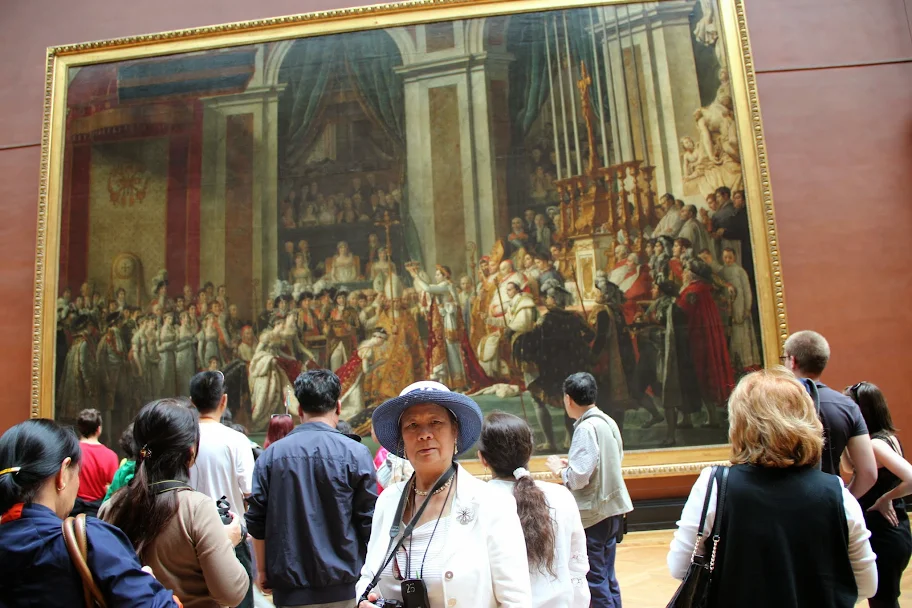The Louvre
Once the biggest palace for the ultimate King, the Louvre now houses the world's grandest art gallery with over 300,000 works of art. First open to the pubic after the French Revolution in 1793, the Louvre is one of the oldest museums in the world. Subscribe tohttp://www.youtube.com/ricksteves for weekly updates on more European destinations. For more information on the Rick Steves' Europe TV series — including episode descriptions, scripts, participating stations, travel information on destinations and more
- Louvre Museum_ Paris_France.

Aerial view of the Louvre Palace
Antonio Canova's Psyche Revived by Cupid's Kiss was commissioned in 1787, donated in 1824
The Venus de Milo was added to the Louvre's collection during the reign of Louis XVIII.
Human-headed winged bull (shedu), Assyria, limestone, 8th century BC.
The Nike of Samothrace(winged Victory), marble, circa 190 BC
The Mona Lisa, (Leonardo da Vinci), oil on panel, 1503–19, probably completed while the artist was at the court of Francis I.
French Rococo, Diana bathing, Boucher, 1742
French Romantic art,Liberty Leading the People, Delacroix, 1830
French Classicism, The Shepherds of Arcadia,Poussin, c.1640


France - Paris, Louvre




Click & hold mouse button down,
drag in any direction to move the view
Zoom in "SHIFT" Zoom out "CTRL"
The Louvre Museum Main Entrance The main entrance through the pyramids. 2011-04-03 |
|







-Liberty Leading the People in Louvre,Paris,France.
-Liberty Leading the People (French: La Liberté guidant le peuple) is a painting by Eugène Delacroix commemorating the July Revolution of 1830, which toppled King Charles X of France. A woman personifying the concept and the goddess of Liberty leads the people forward over the bodies of the fallen, holding the flag of the French Revolution – the tricolor flag which is still France's flag today – in one hand and brandishing a bayonetted musket with the other. The figure of Liberty is also viewed as a symbol of France and the French Republic known as Marianne.

'Raft of the Medusa' in Salle Mollien The Salle Mollien was created and decorated in 1863 for the imperial museum, as conveyed by its red and gold decor. It houses large French Romantic paintings such as The Raft of the Medusa, July 28. Liberty Leading the People and The Death of Sardanapalus are on display here. 2011-04-03 |
|

The Intervention of the Sabine Women is a 1799 painting by the French painter Jacques-Louis David.The painting depicts Romulus's wife Hersilia – the daughter of Titus Tatius, leader of the Sabines – rushing between her husband and her father and placing her babies between them. A vigorous Romulus prepares to strike a half-retreating Tatius with his spear, but hesitates.

The coronation of Napoleon Ion 2 December 1804 at Notre-Dame in an 1807 painting byJacques-
Louis David
The Salle Daru The Salle Daru was created and decorated in 1863 for the imperial museum, as conveyed by its red and gold decor (the French imperial colors). In this section of the Louvre Museum (Musée du Louvre) you can see Davids masterpiece The Consecration of the Emperor Napoleon and the Coronation of Empress Joséphine along other large-scale French Neoclassical paintings. 2011-04-03 |
|


In this room you will find the most famous portrait painting of the world, Mona Lisa (by Leonardo da Vinci). Anybody that visits the Louvre Museum for the first time, wants to see this lady if this is the only work that has to be seen. But this is not the only masterpiece in the room. Opposite to Mona Lisa you can see The Wedding Feast at Cana (by Veronese), a huge (6.77 x 9.94 m) painting, which depicts Jesus 1st miracle, where he turns water to wine. This room is full of wonderful Italian paintings, but these 2 paintings steal the most of the attention. 2011-04-03 |
|
-VIDEO :Secrets of the Mona Lisa Signed BBC Documentary
| Artist | Paolo Veronese |
|---|---|
| Year | 1563 |
| Type | Oil on canvas |
| Dimensions | 666 cm × 990 cm (262 in × 390 in) |
| Location | Louvre, Paris |



AUDREY HEPBURN
The Winged Victory of Samothrace_The Winged Victory of Samothrace, also called the Nike of Samothrace,is a 2nd-century BC marble sculpture of the Greek goddess Nike (Victory). Since 1884, it has been prominently displayed at the Louvre and is one of the most celebrated sculptures in the world. H.W. Janson described it as "the greatest masterpiece of Hellenistic sculpture."
Treasures of the Louvre_BBC :
|

Thank you!
ReplyDelete